Content, Structure, and Presentation of a Research Proposal (BSM 577)
VerifiedAdded on 2019/09/30
|7
|3207
|228
Report
AI Summary
This document outlines the guidelines for a research proposal, specifically tailored for the BSM 577 Research Methods module. It emphasizes the importance of a well-structured proposal as a roadmap for a Master's dissertation, discussing its purpose, content, and presentation. The proposal should include a provisional title, table of contents, abstract, introduction to the research problem, aims and objectives, literature review and rationale, and methodology. The methodology section requires a detailed discussion of research design, sampling, data collection, and analysis methods, alongside justification for the chosen approach. Furthermore, it highlights the necessity of a clear time plan, resource considerations, and ethical issues. The document provides a comprehensive framework for students to craft a research proposal that effectively presents the research problem, relates it to existing literature, and outlines a clear plan for future research, ensuring clarity and detail to facilitate the research process. It is also crucial to address the practicalities of data analysis, including coding and thematic analysis, and to consider the inclusion of appendices such as a draft questionnaire.
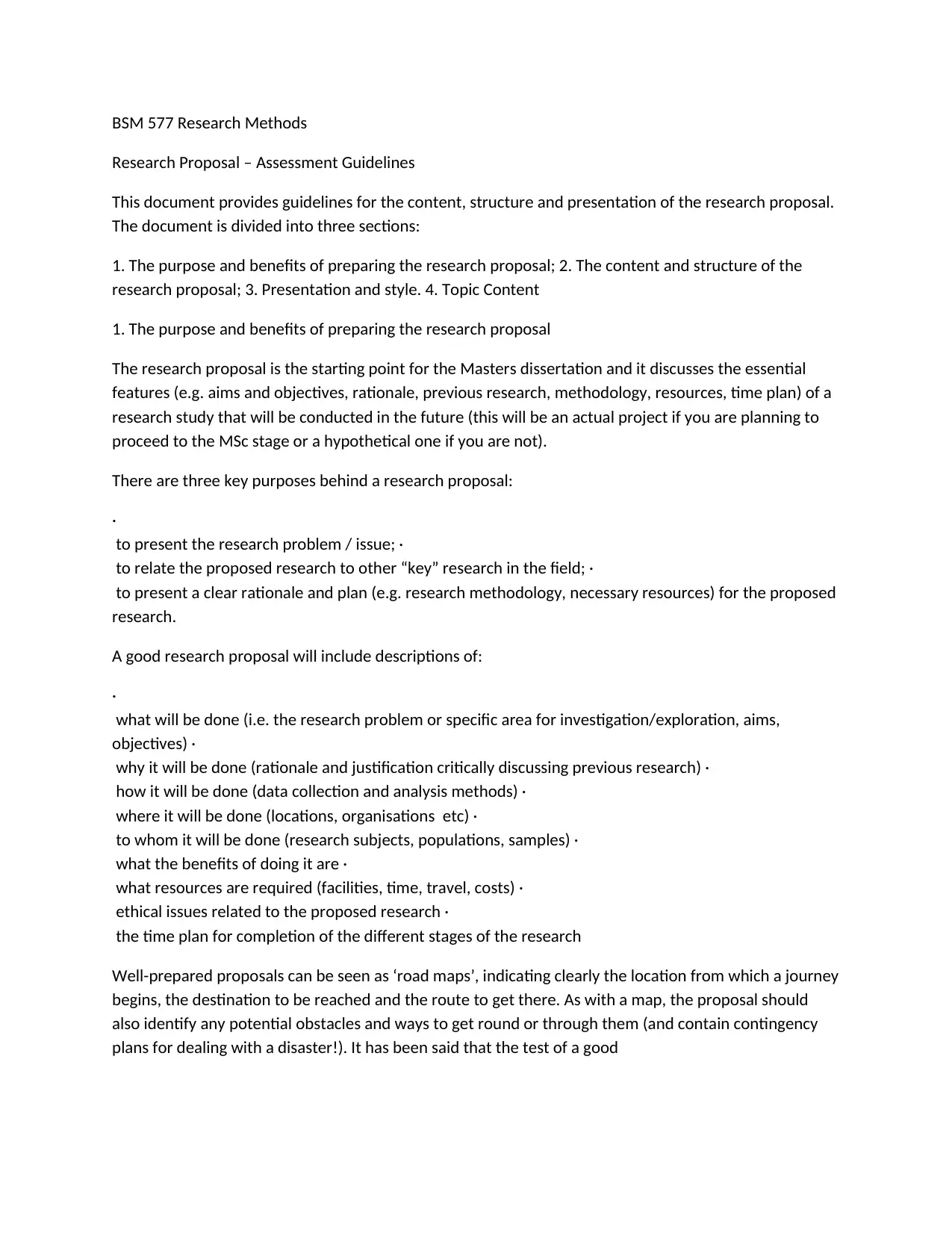
BSM 577 Research Methods
Research Proposal – Assessment Guidelines
This document provides guidelines for the content, structure and presentation of the research proposal.
The document is divided into three sections:
1. The purpose and benefits of preparing the research proposal; 2. The content and structure of the
research proposal; 3. Presentation and style. 4. Topic Content
1. The purpose and benefits of preparing the research proposal
The research proposal is the starting point for the Masters dissertation and it discusses the essential
features (e.g. aims and objectives, rationale, previous research, methodology, resources, time plan) of a
research study that will be conducted in the future (this will be an actual project if you are planning to
proceed to the MSc stage or a hypothetical one if you are not).
There are three key purposes behind a research proposal:
·
to present the research problem / issue; ·
to relate the proposed research to other “key” research in the field; ·
to present a clear rationale and plan (e.g. research methodology, necessary resources) for the proposed
research.
A good research proposal will include descriptions of:
·
what will be done (i.e. the research problem or specific area for investigation/exploration, aims,
objectives) ·
why it will be done (rationale and justification critically discussing previous research) ·
how it will be done (data collection and analysis methods) ·
where it will be done (locations, organisations etc) ·
to whom it will be done (research subjects, populations, samples) ·
what the benefits of doing it are ·
what resources are required (facilities, time, travel, costs) ·
ethical issues related to the proposed research ·
the time plan for completion of the different stages of the research
Well-prepared proposals can be seen as ‘road maps’, indicating clearly the location from which a journey
begins, the destination to be reached and the route to get there. As with a map, the proposal should
also identify any potential obstacles and ways to get round or through them (and contain contingency
plans for dealing with a disaster!). It has been said that the test of a good
Research Proposal – Assessment Guidelines
This document provides guidelines for the content, structure and presentation of the research proposal.
The document is divided into three sections:
1. The purpose and benefits of preparing the research proposal; 2. The content and structure of the
research proposal; 3. Presentation and style. 4. Topic Content
1. The purpose and benefits of preparing the research proposal
The research proposal is the starting point for the Masters dissertation and it discusses the essential
features (e.g. aims and objectives, rationale, previous research, methodology, resources, time plan) of a
research study that will be conducted in the future (this will be an actual project if you are planning to
proceed to the MSc stage or a hypothetical one if you are not).
There are three key purposes behind a research proposal:
·
to present the research problem / issue; ·
to relate the proposed research to other “key” research in the field; ·
to present a clear rationale and plan (e.g. research methodology, necessary resources) for the proposed
research.
A good research proposal will include descriptions of:
·
what will be done (i.e. the research problem or specific area for investigation/exploration, aims,
objectives) ·
why it will be done (rationale and justification critically discussing previous research) ·
how it will be done (data collection and analysis methods) ·
where it will be done (locations, organisations etc) ·
to whom it will be done (research subjects, populations, samples) ·
what the benefits of doing it are ·
what resources are required (facilities, time, travel, costs) ·
ethical issues related to the proposed research ·
the time plan for completion of the different stages of the research
Well-prepared proposals can be seen as ‘road maps’, indicating clearly the location from which a journey
begins, the destination to be reached and the route to get there. As with a map, the proposal should
also identify any potential obstacles and ways to get round or through them (and contain contingency
plans for dealing with a disaster!). It has been said that the test of a good
Paraphrase This Document
Need a fresh take? Get an instant paraphrase of this document with our AI Paraphraser
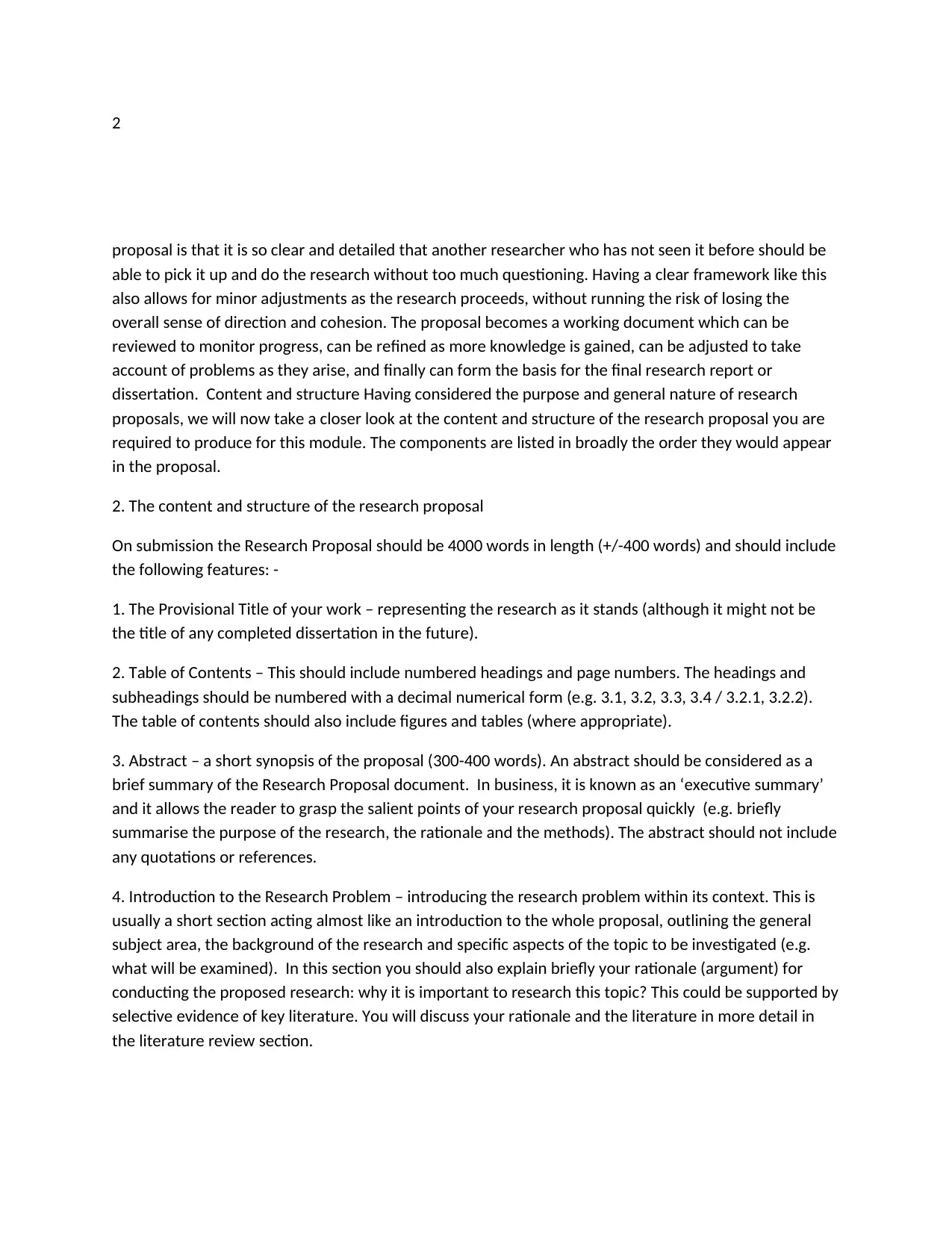
2
proposal is that it is so clear and detailed that another researcher who has not seen it before should be
able to pick it up and do the research without too much questioning. Having a clear framework like this
also allows for minor adjustments as the research proceeds, without running the risk of losing the
overall sense of direction and cohesion. The proposal becomes a working document which can be
reviewed to monitor progress, can be refined as more knowledge is gained, can be adjusted to take
account of problems as they arise, and finally can form the basis for the final research report or
dissertation. Content and structure Having considered the purpose and general nature of research
proposals, we will now take a closer look at the content and structure of the research proposal you are
required to produce for this module. The components are listed in broadly the order they would appear
in the proposal.
2. The content and structure of the research proposal
On submission the Research Proposal should be 4000 words in length (+/-400 words) and should include
the following features: -
1. The Provisional Title of your work – representing the research as it stands (although it might not be
the title of any completed dissertation in the future).
2. Table of Contents – This should include numbered headings and page numbers. The headings and
subheadings should be numbered with a decimal numerical form (e.g. 3.1, 3.2, 3.3, 3.4 / 3.2.1, 3.2.2).
The table of contents should also include figures and tables (where appropriate).
3. Abstract – a short synopsis of the proposal (300-400 words). An abstract should be considered as a
brief summary of the Research Proposal document. In business, it is known as an ‘executive summary’
and it allows the reader to grasp the salient points of your research proposal quickly (e.g. briefly
summarise the purpose of the research, the rationale and the methods). The abstract should not include
any quotations or references.
4. Introduction to the Research Problem – introducing the research problem within its context. This is
usually a short section acting almost like an introduction to the whole proposal, outlining the general
subject area, the background of the research and specific aspects of the topic to be investigated (e.g.
what will be examined). In this section you should also explain briefly your rationale (argument) for
conducting the proposed research: why it is important to research this topic? This could be supported by
selective evidence of key literature. You will discuss your rationale and the literature in more detail in
the literature review section.
proposal is that it is so clear and detailed that another researcher who has not seen it before should be
able to pick it up and do the research without too much questioning. Having a clear framework like this
also allows for minor adjustments as the research proceeds, without running the risk of losing the
overall sense of direction and cohesion. The proposal becomes a working document which can be
reviewed to monitor progress, can be refined as more knowledge is gained, can be adjusted to take
account of problems as they arise, and finally can form the basis for the final research report or
dissertation. Content and structure Having considered the purpose and general nature of research
proposals, we will now take a closer look at the content and structure of the research proposal you are
required to produce for this module. The components are listed in broadly the order they would appear
in the proposal.
2. The content and structure of the research proposal
On submission the Research Proposal should be 4000 words in length (+/-400 words) and should include
the following features: -
1. The Provisional Title of your work – representing the research as it stands (although it might not be
the title of any completed dissertation in the future).
2. Table of Contents – This should include numbered headings and page numbers. The headings and
subheadings should be numbered with a decimal numerical form (e.g. 3.1, 3.2, 3.3, 3.4 / 3.2.1, 3.2.2).
The table of contents should also include figures and tables (where appropriate).
3. Abstract – a short synopsis of the proposal (300-400 words). An abstract should be considered as a
brief summary of the Research Proposal document. In business, it is known as an ‘executive summary’
and it allows the reader to grasp the salient points of your research proposal quickly (e.g. briefly
summarise the purpose of the research, the rationale and the methods). The abstract should not include
any quotations or references.
4. Introduction to the Research Problem – introducing the research problem within its context. This is
usually a short section acting almost like an introduction to the whole proposal, outlining the general
subject area, the background of the research and specific aspects of the topic to be investigated (e.g.
what will be examined). In this section you should also explain briefly your rationale (argument) for
conducting the proposed research: why it is important to research this topic? This could be supported by
selective evidence of key literature. You will discuss your rationale and the literature in more detail in
the literature review section.
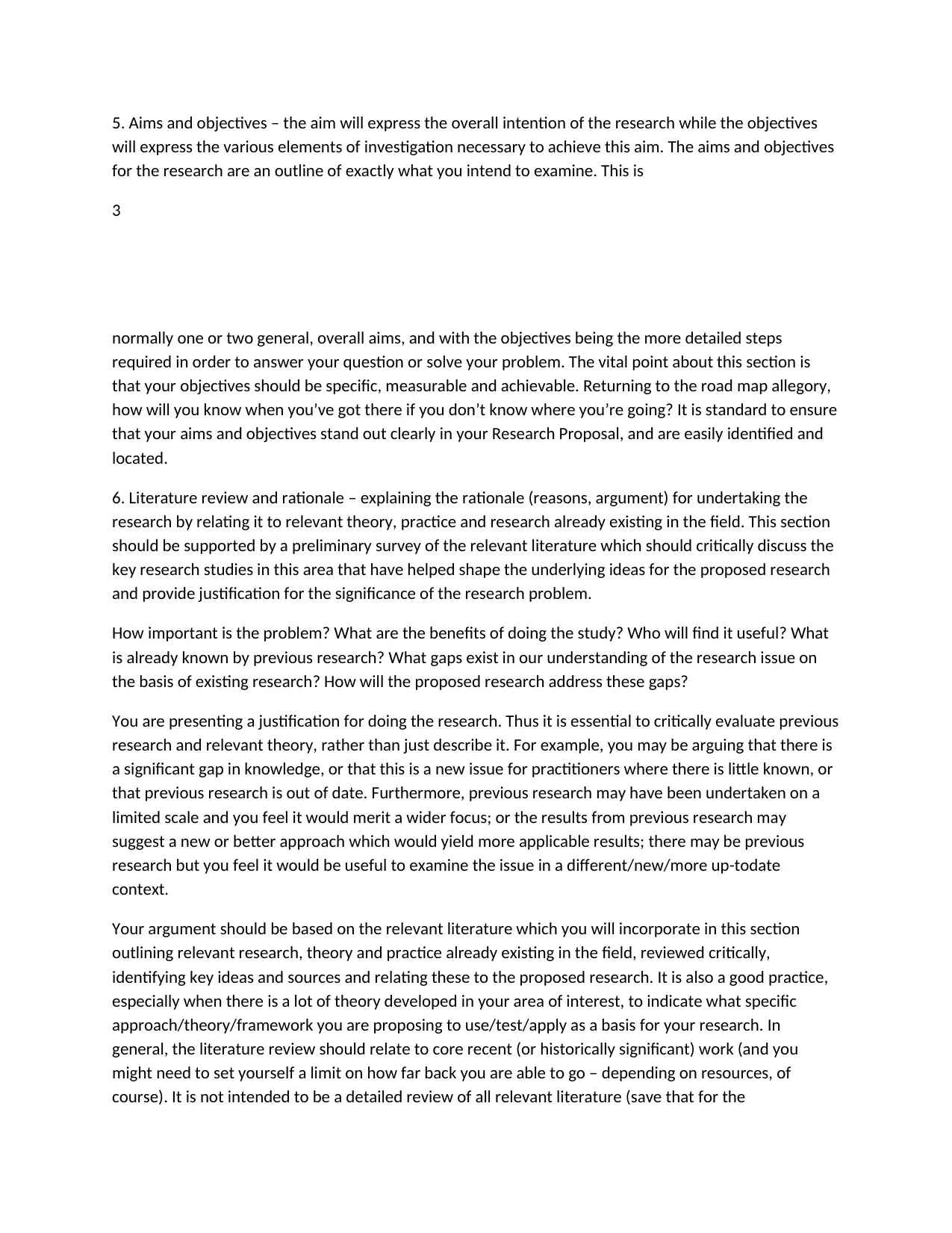
5. Aims and objectives – the aim will express the overall intention of the research while the objectives
will express the various elements of investigation necessary to achieve this aim. The aims and objectives
for the research are an outline of exactly what you intend to examine. This is
3
normally one or two general, overall aims, and with the objectives being the more detailed steps
required in order to answer your question or solve your problem. The vital point about this section is
that your objectives should be specific, measurable and achievable. Returning to the road map allegory,
how will you know when you’ve got there if you don’t know where you’re going? It is standard to ensure
that your aims and objectives stand out clearly in your Research Proposal, and are easily identified and
located.
6. Literature review and rationale – explaining the rationale (reasons, argument) for undertaking the
research by relating it to relevant theory, practice and research already existing in the field. This section
should be supported by a preliminary survey of the relevant literature which should critically discuss the
key research studies in this area that have helped shape the underlying ideas for the proposed research
and provide justification for the significance of the research problem.
How important is the problem? What are the benefits of doing the study? Who will find it useful? What
is already known by previous research? What gaps exist in our understanding of the research issue on
the basis of existing research? How will the proposed research address these gaps?
You are presenting a justification for doing the research. Thus it is essential to critically evaluate previous
research and relevant theory, rather than just describe it. For example, you may be arguing that there is
a significant gap in knowledge, or that this is a new issue for practitioners where there is little known, or
that previous research is out of date. Furthermore, previous research may have been undertaken on a
limited scale and you feel it would merit a wider focus; or the results from previous research may
suggest a new or better approach which would yield more applicable results; there may be previous
research but you feel it would be useful to examine the issue in a different/new/more up-todate
context.
Your argument should be based on the relevant literature which you will incorporate in this section
outlining relevant research, theory and practice already existing in the field, reviewed critically,
identifying key ideas and sources and relating these to the proposed research. It is also a good practice,
especially when there is a lot of theory developed in your area of interest, to indicate what specific
approach/theory/framework you are proposing to use/test/apply as a basis for your research. In
general, the literature review should relate to core recent (or historically significant) work (and you
might need to set yourself a limit on how far back you are able to go – depending on resources, of
course). It is not intended to be a detailed review of all relevant literature (save that for the
will express the various elements of investigation necessary to achieve this aim. The aims and objectives
for the research are an outline of exactly what you intend to examine. This is
3
normally one or two general, overall aims, and with the objectives being the more detailed steps
required in order to answer your question or solve your problem. The vital point about this section is
that your objectives should be specific, measurable and achievable. Returning to the road map allegory,
how will you know when you’ve got there if you don’t know where you’re going? It is standard to ensure
that your aims and objectives stand out clearly in your Research Proposal, and are easily identified and
located.
6. Literature review and rationale – explaining the rationale (reasons, argument) for undertaking the
research by relating it to relevant theory, practice and research already existing in the field. This section
should be supported by a preliminary survey of the relevant literature which should critically discuss the
key research studies in this area that have helped shape the underlying ideas for the proposed research
and provide justification for the significance of the research problem.
How important is the problem? What are the benefits of doing the study? Who will find it useful? What
is already known by previous research? What gaps exist in our understanding of the research issue on
the basis of existing research? How will the proposed research address these gaps?
You are presenting a justification for doing the research. Thus it is essential to critically evaluate previous
research and relevant theory, rather than just describe it. For example, you may be arguing that there is
a significant gap in knowledge, or that this is a new issue for practitioners where there is little known, or
that previous research is out of date. Furthermore, previous research may have been undertaken on a
limited scale and you feel it would merit a wider focus; or the results from previous research may
suggest a new or better approach which would yield more applicable results; there may be previous
research but you feel it would be useful to examine the issue in a different/new/more up-todate
context.
Your argument should be based on the relevant literature which you will incorporate in this section
outlining relevant research, theory and practice already existing in the field, reviewed critically,
identifying key ideas and sources and relating these to the proposed research. It is also a good practice,
especially when there is a lot of theory developed in your area of interest, to indicate what specific
approach/theory/framework you are proposing to use/test/apply as a basis for your research. In
general, the literature review should relate to core recent (or historically significant) work (and you
might need to set yourself a limit on how far back you are able to go – depending on resources, of
course). It is not intended to be a detailed review of all relevant literature (save that for the
You're viewing a preview
Unlock full access by subscribing today!
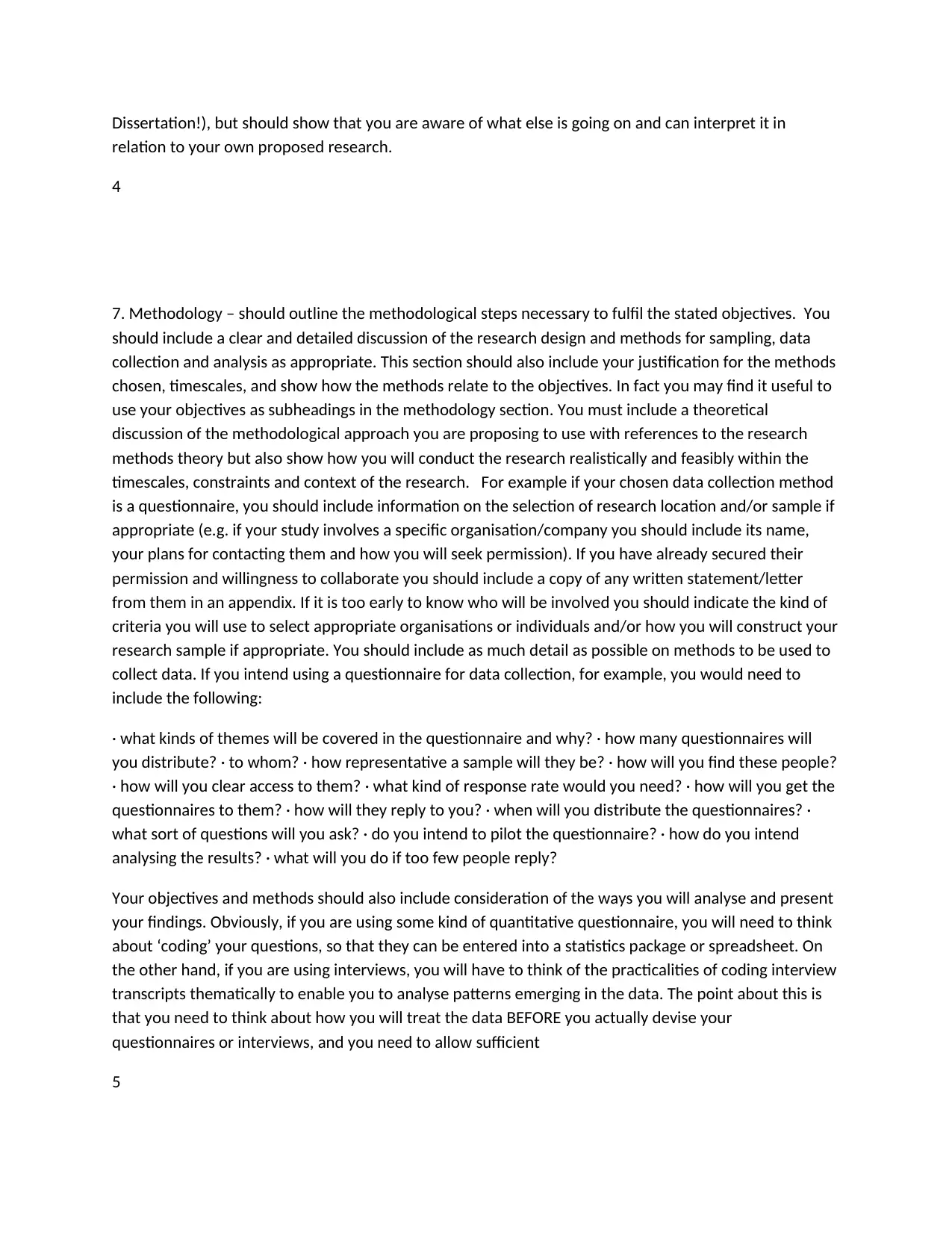
Dissertation!), but should show that you are aware of what else is going on and can interpret it in
relation to your own proposed research.
4
7. Methodology – should outline the methodological steps necessary to fulfil the stated objectives. You
should include a clear and detailed discussion of the research design and methods for sampling, data
collection and analysis as appropriate. This section should also include your justification for the methods
chosen, timescales, and show how the methods relate to the objectives. In fact you may find it useful to
use your objectives as subheadings in the methodology section. You must include a theoretical
discussion of the methodological approach you are proposing to use with references to the research
methods theory but also show how you will conduct the research realistically and feasibly within the
timescales, constraints and context of the research. For example if your chosen data collection method
is a questionnaire, you should include information on the selection of research location and/or sample if
appropriate (e.g. if your study involves a specific organisation/company you should include its name,
your plans for contacting them and how you will seek permission). If you have already secured their
permission and willingness to collaborate you should include a copy of any written statement/letter
from them in an appendix. If it is too early to know who will be involved you should indicate the kind of
criteria you will use to select appropriate organisations or individuals and/or how you will construct your
research sample if appropriate. You should include as much detail as possible on methods to be used to
collect data. If you intend using a questionnaire for data collection, for example, you would need to
include the following:
· what kinds of themes will be covered in the questionnaire and why? · how many questionnaires will
you distribute? · to whom? · how representative a sample will they be? · how will you find these people?
· how will you clear access to them? · what kind of response rate would you need? · how will you get the
questionnaires to them? · how will they reply to you? · when will you distribute the questionnaires? ·
what sort of questions will you ask? · do you intend to pilot the questionnaire? · how do you intend
analysing the results? · what will you do if too few people reply?
Your objectives and methods should also include consideration of the ways you will analyse and present
your findings. Obviously, if you are using some kind of quantitative questionnaire, you will need to think
about ‘coding’ your questions, so that they can be entered into a statistics package or spreadsheet. On
the other hand, if you are using interviews, you will have to think of the practicalities of coding interview
transcripts thematically to enable you to analyse patterns emerging in the data. The point about this is
that you need to think about how you will treat the data BEFORE you actually devise your
questionnaires or interviews, and you need to allow sufficient
5
relation to your own proposed research.
4
7. Methodology – should outline the methodological steps necessary to fulfil the stated objectives. You
should include a clear and detailed discussion of the research design and methods for sampling, data
collection and analysis as appropriate. This section should also include your justification for the methods
chosen, timescales, and show how the methods relate to the objectives. In fact you may find it useful to
use your objectives as subheadings in the methodology section. You must include a theoretical
discussion of the methodological approach you are proposing to use with references to the research
methods theory but also show how you will conduct the research realistically and feasibly within the
timescales, constraints and context of the research. For example if your chosen data collection method
is a questionnaire, you should include information on the selection of research location and/or sample if
appropriate (e.g. if your study involves a specific organisation/company you should include its name,
your plans for contacting them and how you will seek permission). If you have already secured their
permission and willingness to collaborate you should include a copy of any written statement/letter
from them in an appendix. If it is too early to know who will be involved you should indicate the kind of
criteria you will use to select appropriate organisations or individuals and/or how you will construct your
research sample if appropriate. You should include as much detail as possible on methods to be used to
collect data. If you intend using a questionnaire for data collection, for example, you would need to
include the following:
· what kinds of themes will be covered in the questionnaire and why? · how many questionnaires will
you distribute? · to whom? · how representative a sample will they be? · how will you find these people?
· how will you clear access to them? · what kind of response rate would you need? · how will you get the
questionnaires to them? · how will they reply to you? · when will you distribute the questionnaires? ·
what sort of questions will you ask? · do you intend to pilot the questionnaire? · how do you intend
analysing the results? · what will you do if too few people reply?
Your objectives and methods should also include consideration of the ways you will analyse and present
your findings. Obviously, if you are using some kind of quantitative questionnaire, you will need to think
about ‘coding’ your questions, so that they can be entered into a statistics package or spreadsheet. On
the other hand, if you are using interviews, you will have to think of the practicalities of coding interview
transcripts thematically to enable you to analyse patterns emerging in the data. The point about this is
that you need to think about how you will treat the data BEFORE you actually devise your
questionnaires or interviews, and you need to allow sufficient
5
Paraphrase This Document
Need a fresh take? Get an instant paraphrase of this document with our AI Paraphraser
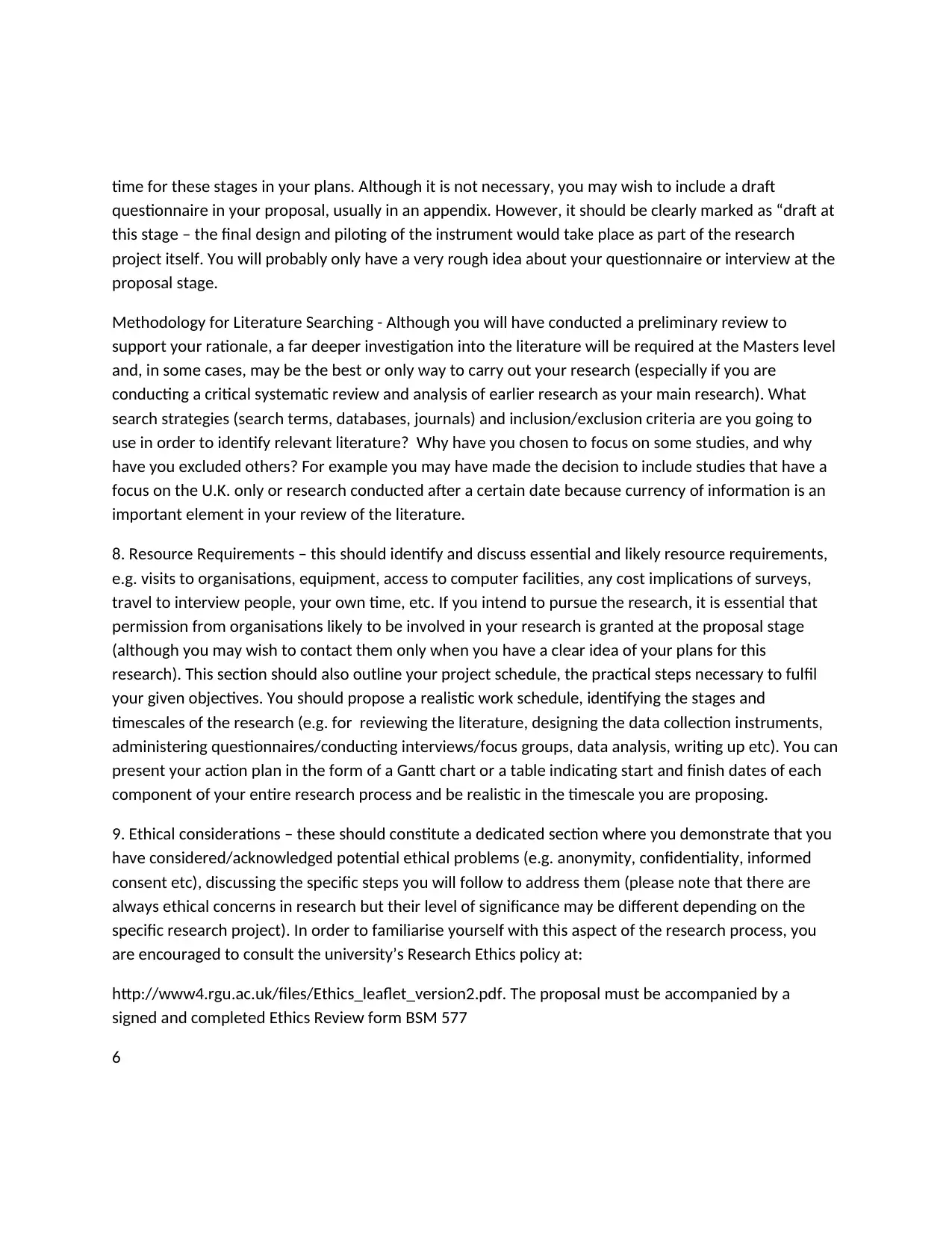
time for these stages in your plans. Although it is not necessary, you may wish to include a draft
questionnaire in your proposal, usually in an appendix. However, it should be clearly marked as “draft at
this stage – the final design and piloting of the instrument would take place as part of the research
project itself. You will probably only have a very rough idea about your questionnaire or interview at the
proposal stage.
Methodology for Literature Searching - Although you will have conducted a preliminary review to
support your rationale, a far deeper investigation into the literature will be required at the Masters level
and, in some cases, may be the best or only way to carry out your research (especially if you are
conducting a critical systematic review and analysis of earlier research as your main research). What
search strategies (search terms, databases, journals) and inclusion/exclusion criteria are you going to
use in order to identify relevant literature? Why have you chosen to focus on some studies, and why
have you excluded others? For example you may have made the decision to include studies that have a
focus on the U.K. only or research conducted after a certain date because currency of information is an
important element in your review of the literature.
8. Resource Requirements – this should identify and discuss essential and likely resource requirements,
e.g. visits to organisations, equipment, access to computer facilities, any cost implications of surveys,
travel to interview people, your own time, etc. If you intend to pursue the research, it is essential that
permission from organisations likely to be involved in your research is granted at the proposal stage
(although you may wish to contact them only when you have a clear idea of your plans for this
research). This section should also outline your project schedule, the practical steps necessary to fulfil
your given objectives. You should propose a realistic work schedule, identifying the stages and
timescales of the research (e.g. for reviewing the literature, designing the data collection instruments,
administering questionnaires/conducting interviews/focus groups, data analysis, writing up etc). You can
present your action plan in the form of a Gantt chart or a table indicating start and finish dates of each
component of your entire research process and be realistic in the timescale you are proposing.
9. Ethical considerations – these should constitute a dedicated section where you demonstrate that you
have considered/acknowledged potential ethical problems (e.g. anonymity, confidentiality, informed
consent etc), discussing the specific steps you will follow to address them (please note that there are
always ethical concerns in research but their level of significance may be different depending on the
specific research project). In order to familiarise yourself with this aspect of the research process, you
are encouraged to consult the university’s Research Ethics policy at:
http://www4.rgu.ac.uk/files/Ethics_leaflet_version2.pdf. The proposal must be accompanied by a
signed and completed Ethics Review form BSM 577
6
questionnaire in your proposal, usually in an appendix. However, it should be clearly marked as “draft at
this stage – the final design and piloting of the instrument would take place as part of the research
project itself. You will probably only have a very rough idea about your questionnaire or interview at the
proposal stage.
Methodology for Literature Searching - Although you will have conducted a preliminary review to
support your rationale, a far deeper investigation into the literature will be required at the Masters level
and, in some cases, may be the best or only way to carry out your research (especially if you are
conducting a critical systematic review and analysis of earlier research as your main research). What
search strategies (search terms, databases, journals) and inclusion/exclusion criteria are you going to
use in order to identify relevant literature? Why have you chosen to focus on some studies, and why
have you excluded others? For example you may have made the decision to include studies that have a
focus on the U.K. only or research conducted after a certain date because currency of information is an
important element in your review of the literature.
8. Resource Requirements – this should identify and discuss essential and likely resource requirements,
e.g. visits to organisations, equipment, access to computer facilities, any cost implications of surveys,
travel to interview people, your own time, etc. If you intend to pursue the research, it is essential that
permission from organisations likely to be involved in your research is granted at the proposal stage
(although you may wish to contact them only when you have a clear idea of your plans for this
research). This section should also outline your project schedule, the practical steps necessary to fulfil
your given objectives. You should propose a realistic work schedule, identifying the stages and
timescales of the research (e.g. for reviewing the literature, designing the data collection instruments,
administering questionnaires/conducting interviews/focus groups, data analysis, writing up etc). You can
present your action plan in the form of a Gantt chart or a table indicating start and finish dates of each
component of your entire research process and be realistic in the timescale you are proposing.
9. Ethical considerations – these should constitute a dedicated section where you demonstrate that you
have considered/acknowledged potential ethical problems (e.g. anonymity, confidentiality, informed
consent etc), discussing the specific steps you will follow to address them (please note that there are
always ethical concerns in research but their level of significance may be different depending on the
specific research project). In order to familiarise yourself with this aspect of the research process, you
are encouraged to consult the university’s Research Ethics policy at:
http://www4.rgu.ac.uk/files/Ethics_leaflet_version2.pdf. The proposal must be accompanied by a
signed and completed Ethics Review form BSM 577
6
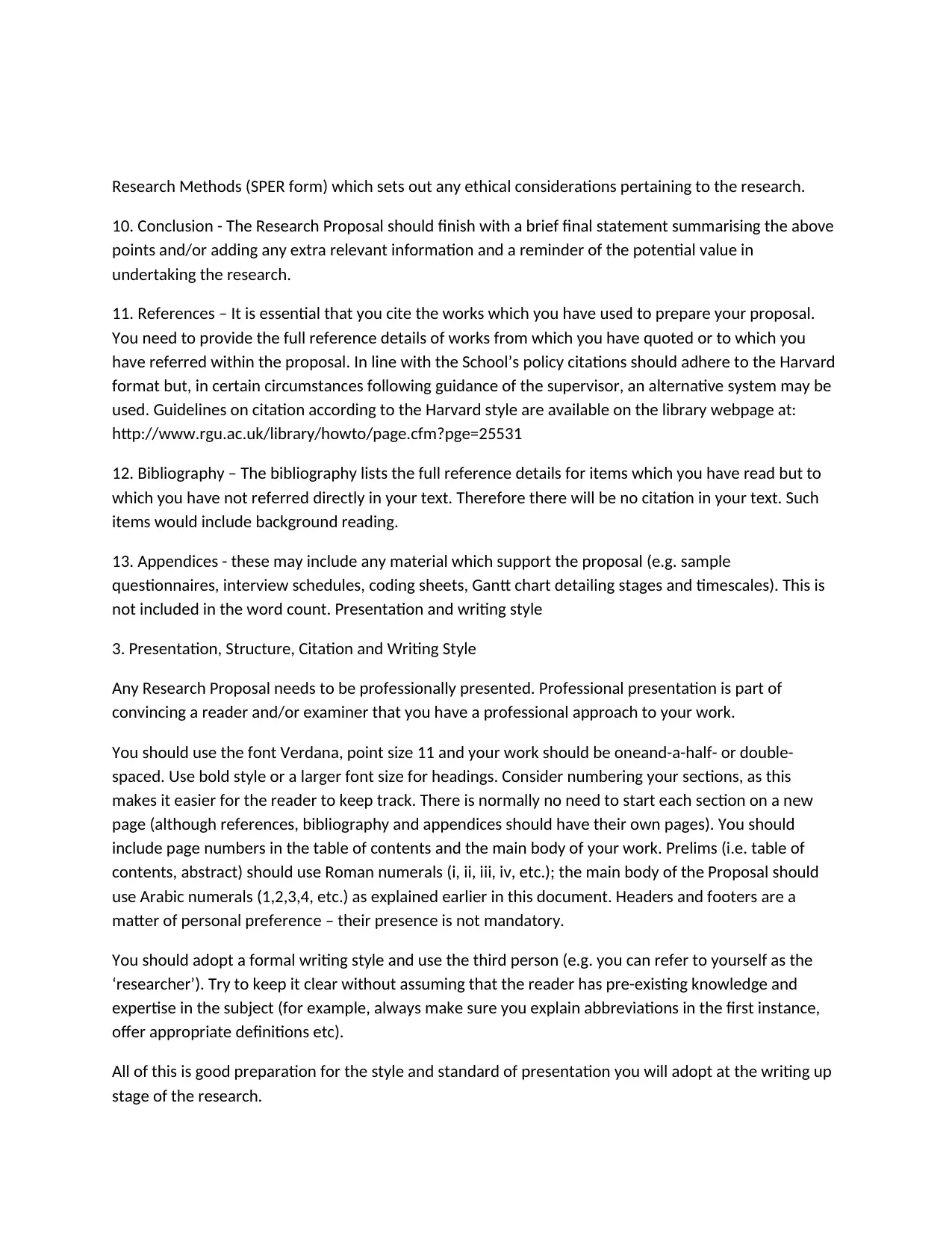
Research Methods (SPER form) which sets out any ethical considerations pertaining to the research.
10. Conclusion - The Research Proposal should finish with a brief final statement summarising the above
points and/or adding any extra relevant information and a reminder of the potential value in
undertaking the research.
11. References – It is essential that you cite the works which you have used to prepare your proposal.
You need to provide the full reference details of works from which you have quoted or to which you
have referred within the proposal. In line with the School’s policy citations should adhere to the Harvard
format but, in certain circumstances following guidance of the supervisor, an alternative system may be
used. Guidelines on citation according to the Harvard style are available on the library webpage at:
http://www.rgu.ac.uk/library/howto/page.cfm?pge=25531
12. Bibliography – The bibliography lists the full reference details for items which you have read but to
which you have not referred directly in your text. Therefore there will be no citation in your text. Such
items would include background reading.
13. Appendices - these may include any material which support the proposal (e.g. sample
questionnaires, interview schedules, coding sheets, Gantt chart detailing stages and timescales). This is
not included in the word count. Presentation and writing style
3. Presentation, Structure, Citation and Writing Style
Any Research Proposal needs to be professionally presented. Professional presentation is part of
convincing a reader and/or examiner that you have a professional approach to your work.
You should use the font Verdana, point size 11 and your work should be oneand-a-half- or double-
spaced. Use bold style or a larger font size for headings. Consider numbering your sections, as this
makes it easier for the reader to keep track. There is normally no need to start each section on a new
page (although references, bibliography and appendices should have their own pages). You should
include page numbers in the table of contents and the main body of your work. Prelims (i.e. table of
contents, abstract) should use Roman numerals (i, ii, iii, iv, etc.); the main body of the Proposal should
use Arabic numerals (1,2,3,4, etc.) as explained earlier in this document. Headers and footers are a
matter of personal preference – their presence is not mandatory.
You should adopt a formal writing style and use the third person (e.g. you can refer to yourself as the
‘researcher’). Try to keep it clear without assuming that the reader has pre-existing knowledge and
expertise in the subject (for example, always make sure you explain abbreviations in the first instance,
offer appropriate definitions etc).
All of this is good preparation for the style and standard of presentation you will adopt at the writing up
stage of the research.
10. Conclusion - The Research Proposal should finish with a brief final statement summarising the above
points and/or adding any extra relevant information and a reminder of the potential value in
undertaking the research.
11. References – It is essential that you cite the works which you have used to prepare your proposal.
You need to provide the full reference details of works from which you have quoted or to which you
have referred within the proposal. In line with the School’s policy citations should adhere to the Harvard
format but, in certain circumstances following guidance of the supervisor, an alternative system may be
used. Guidelines on citation according to the Harvard style are available on the library webpage at:
http://www.rgu.ac.uk/library/howto/page.cfm?pge=25531
12. Bibliography – The bibliography lists the full reference details for items which you have read but to
which you have not referred directly in your text. Therefore there will be no citation in your text. Such
items would include background reading.
13. Appendices - these may include any material which support the proposal (e.g. sample
questionnaires, interview schedules, coding sheets, Gantt chart detailing stages and timescales). This is
not included in the word count. Presentation and writing style
3. Presentation, Structure, Citation and Writing Style
Any Research Proposal needs to be professionally presented. Professional presentation is part of
convincing a reader and/or examiner that you have a professional approach to your work.
You should use the font Verdana, point size 11 and your work should be oneand-a-half- or double-
spaced. Use bold style or a larger font size for headings. Consider numbering your sections, as this
makes it easier for the reader to keep track. There is normally no need to start each section on a new
page (although references, bibliography and appendices should have their own pages). You should
include page numbers in the table of contents and the main body of your work. Prelims (i.e. table of
contents, abstract) should use Roman numerals (i, ii, iii, iv, etc.); the main body of the Proposal should
use Arabic numerals (1,2,3,4, etc.) as explained earlier in this document. Headers and footers are a
matter of personal preference – their presence is not mandatory.
You should adopt a formal writing style and use the third person (e.g. you can refer to yourself as the
‘researcher’). Try to keep it clear without assuming that the reader has pre-existing knowledge and
expertise in the subject (for example, always make sure you explain abbreviations in the first instance,
offer appropriate definitions etc).
All of this is good preparation for the style and standard of presentation you will adopt at the writing up
stage of the research.
You're viewing a preview
Unlock full access by subscribing today!
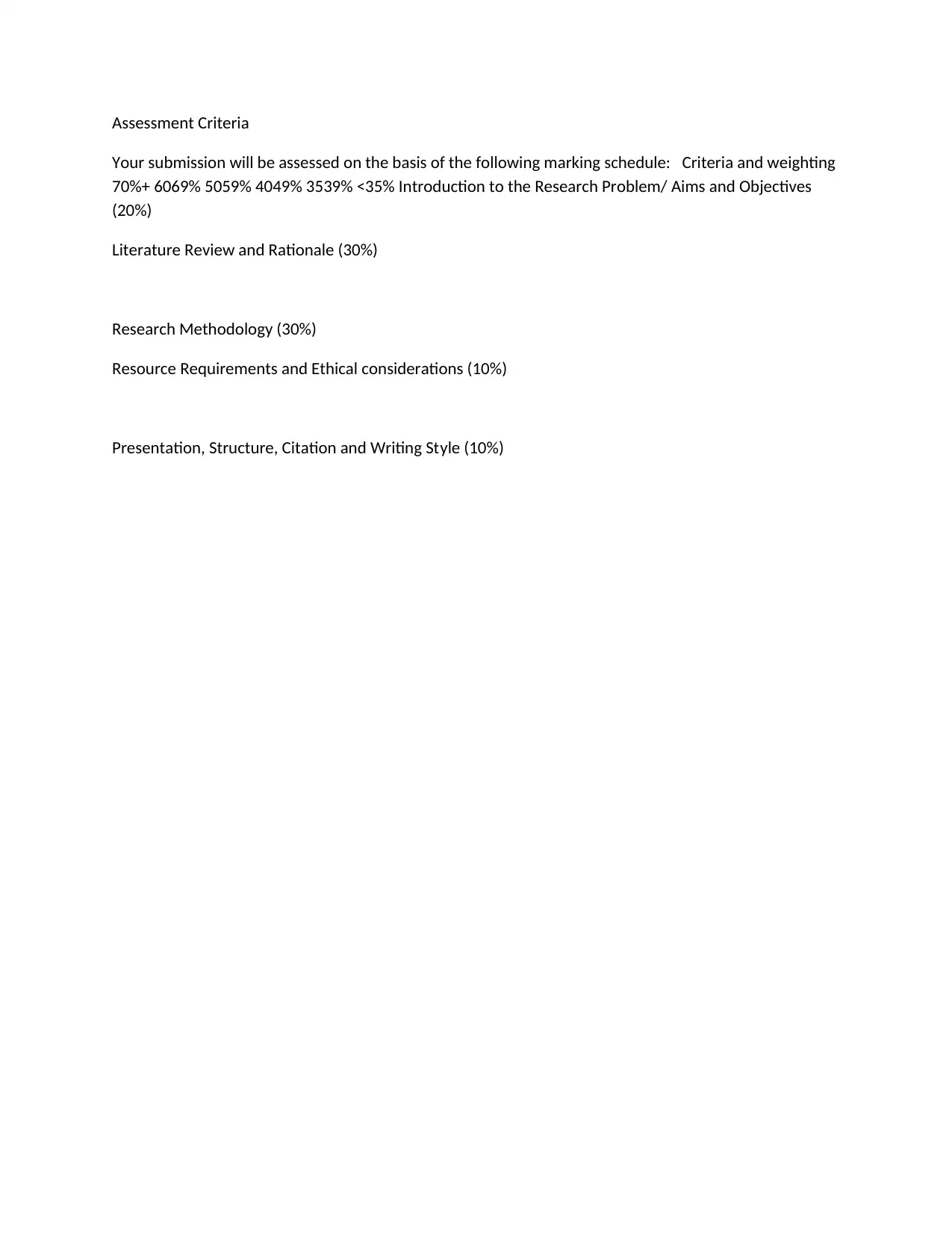
Assessment Criteria
Your submission will be assessed on the basis of the following marking schedule: Criteria and weighting
70%+ 6069% 5059% 4049% 3539% <35% Introduction to the Research Problem/ Aims and Objectives
(20%)
Literature Review and Rationale (30%)
Research Methodology (30%)
Resource Requirements and Ethical considerations (10%)
Presentation, Structure, Citation and Writing Style (10%)
Your submission will be assessed on the basis of the following marking schedule: Criteria and weighting
70%+ 6069% 5059% 4049% 3539% <35% Introduction to the Research Problem/ Aims and Objectives
(20%)
Literature Review and Rationale (30%)
Research Methodology (30%)
Resource Requirements and Ethical considerations (10%)
Presentation, Structure, Citation and Writing Style (10%)
1 out of 7
Related Documents
Your All-in-One AI-Powered Toolkit for Academic Success.
+13062052269
info@desklib.com
Available 24*7 on WhatsApp / Email
![[object Object]](/_next/static/media/star-bottom.7253800d.svg)
Unlock your academic potential
© 2024 | Zucol Services PVT LTD | All rights reserved.





